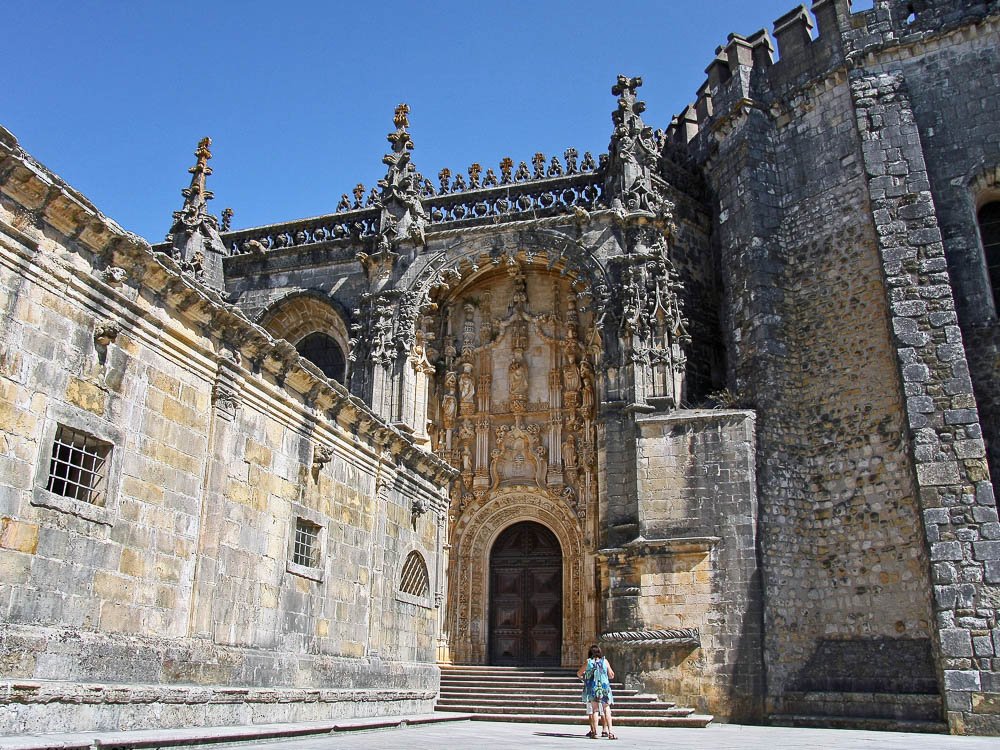Located in the town of Tomar, the Convent of Christ (Convento de Cristo) is a treasure of Portugal’s historical heritage. This site, including the Templar Castle and the Convent of the Knights of Christ, became a UNESCO World Heritage monument in 1983.
Spanning over seven centuries, its history encapsulates key phases of both Portuguese and Western civilization. The grounds, for example, were once sacred to Roman cults, exuding a deep cultural significance.
Wandering through the complex, I felt transported through time, from the medieval Templar stronghold to the Renaissance elegance introduced by King Manuel I. Each corner of the convent reflects a different era, making the history come alive in an immersive way.
Knowing the background of the Convent before visiting deepened my appreciation for its resilience, preservation and spiritual and artistic legacy.
Whether you’re a history buff or a curious traveler, Tomar’s Convent of Christ is a must-see! In this guide, I’ll tell you everything you need to know to make your visit all the more special.
Convent of Christ – in a nutshell
- Highlights: cloisters, Manueline window, charola
- Opening hours: May-October: 9 am – 5:30 pm. June-September: 9 am – 6:30 pm.
- Tickets: € 10
- Address: Convent of Christ/Church of the Templar Castle, 2300-000, Tomar
- Nearest metro station: Tomar
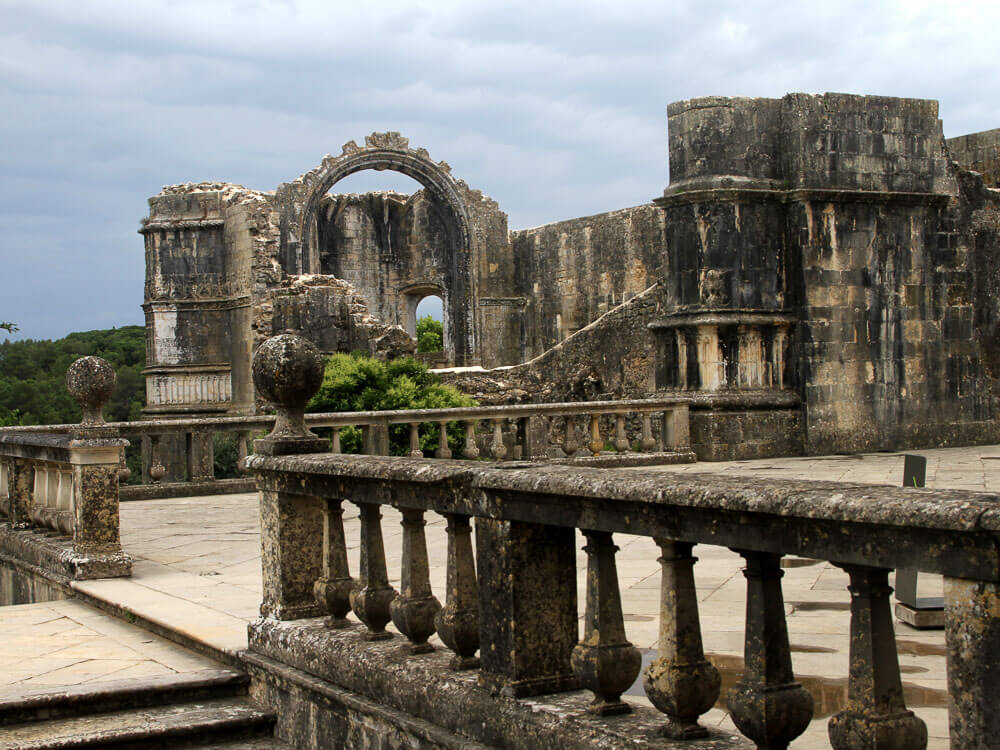
Index
- Highlights of the Convent of Christ
- Events and cultural activities
- How to get tickets?
- Opening hours and facilities
- How to get there?
- Nearby attractions
- History
- Architecture
1. Highlights of the Convent of Christ
1.1. The Charola
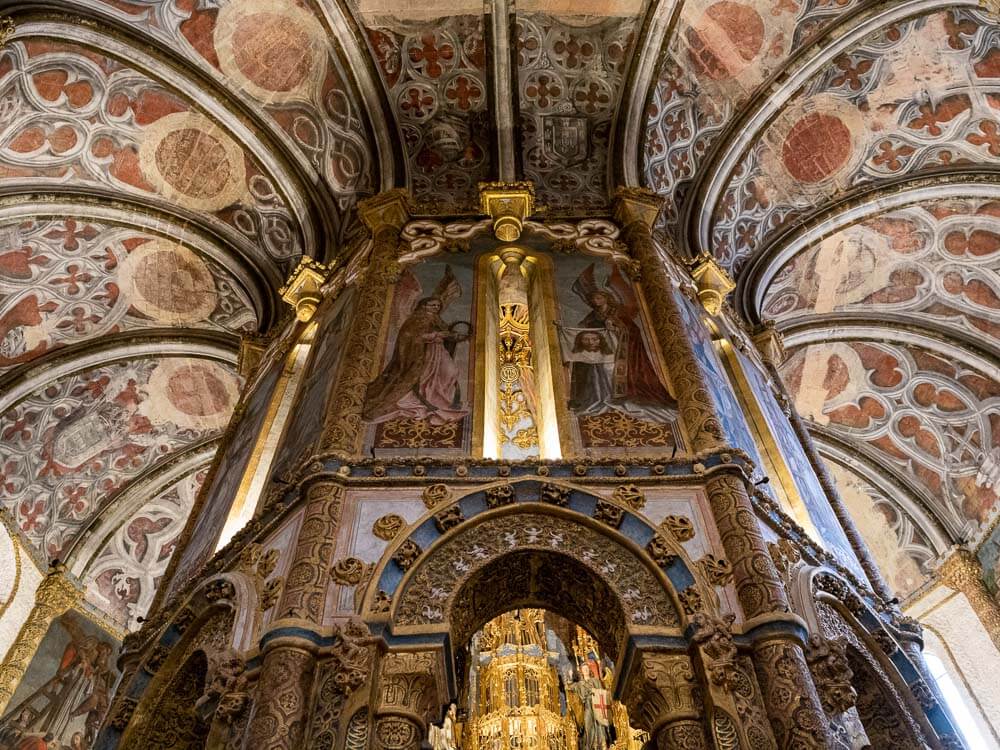
The Charola began as a Romanesque Templar church in the late 12th century, with a design that mirrors the Church of the Holy Sepulchre in Jerusalem. It features a distinctive sixteen-sided exterior and an octagonal interior that captivate visitors and historians alike.
In the 16th century, King Manuel I infused the Charola with artistic elements that blend Templar traditions and Renaissance influences. The additions of altarpiece paintings, murals, stucco work, and intricate carvings transformed the space into both a center of worship and a cultural artifact.
Renowned for its fusion of architectural styles, the Charola stands as a key religious structure in Portugal. The melding of Templar and Renaissance details underscores its importance in Portuguese history, drawing numerous visitors to Tomar’s Convento de Cristo.
1.2. The Cloisters

If you’re as fascinated by cloisters as I am, you’ll love the Convento de Cristo in Tomar, renowned for its great variety of cloisters, each with unique functions and architectural styles.
The Cemetery Cloister played a solemn role, hosting funeral processions and knight burials. On the other hand, the Laundry Cloister was equipped with a stone cistern for washing the friars’ habits, showcasing its practical design.
The Micha Cloister, built between 1543 and 1550, was where bread was distributed to those in need, reflecting the convent’s dedication to community support. The Ravens’ Cloister, from the 16th century, offered a tranquil space for prayer and study. Nearby, the south wing housed a library and scriptorium close to the Prior’s residence.
Saint Barbara’s Cloister, designed by João de Castilho, served primarily for distribution activities. The Hostelry Cloister, constructed between 1541-1542, provided guest housing, stables, and an infirmary to cater to visitors’ needs.
Another highlight among them is the Main or King João III’s Cloister, built in the 1530s. This cloister is a Renaissance masterpiece, particularly after Filipe Terzi’s enhancements.
1.3. The Manueline Window
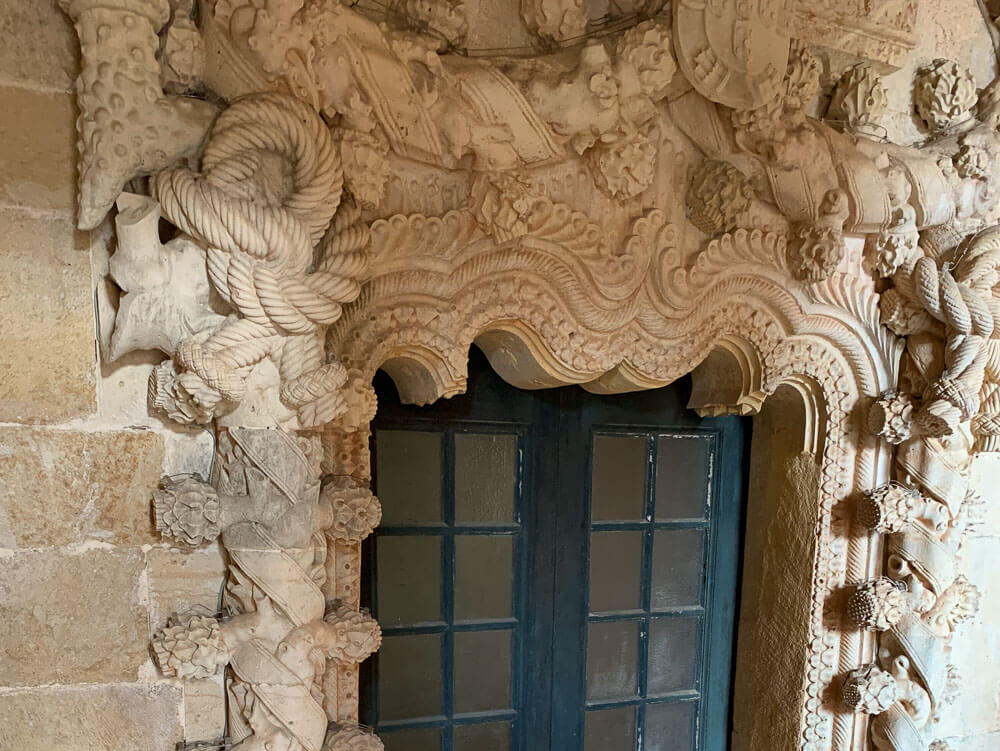
The Manueline Window, or Janela do Capítulo, is a standout feature of the Convento de Cristo in Tomar. Located within the serene Saint Barbara’s Cloister (Claustro Santa Barbara), it was created between 1510 and 1513 by Diogo Arruda, who also worked on Lisbon’s Belém Tower.
This window exemplifies late-Gothic Manueline architecture, and Diogo and his brother Francisco Arruda infused it with intricate religious and maritime elements, making it a symbol of Portugal’s Age of Exploration.
The window’s complex motifs include the Tree of Life and nautical symbols like ropes, knots, globes, and crosses, a true testament to Portugal’s rich heritage of exploration and sea travel.
1.4. Interiors
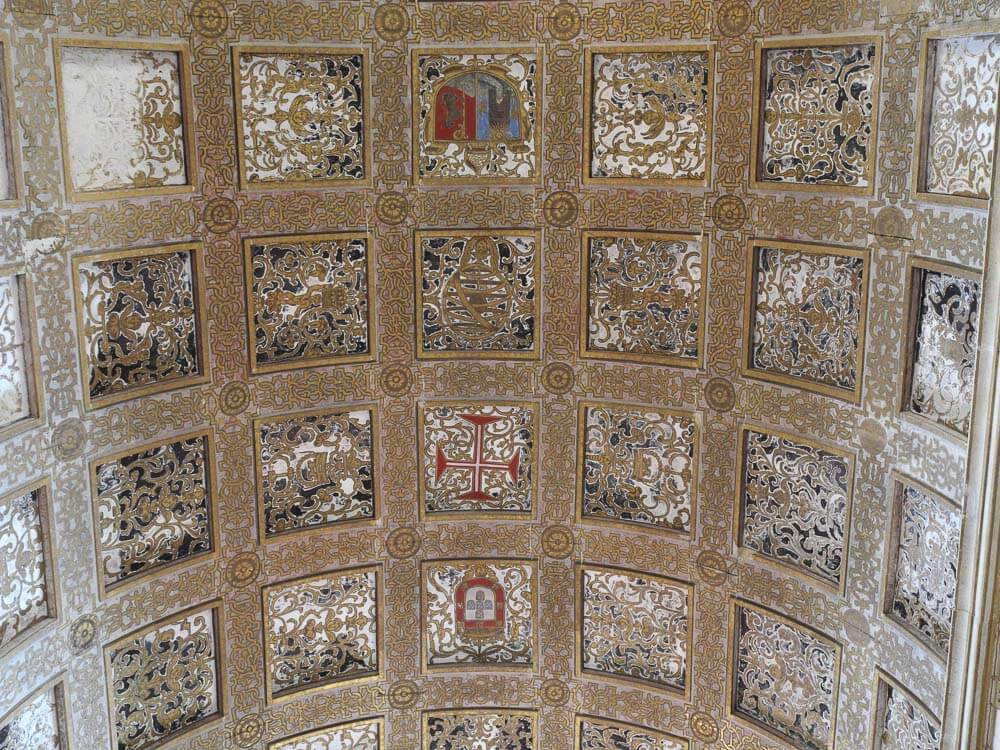
The main body of the Convent of Christ’s church, with its nave and choir, is connected to the Charola via an elegantly designed portal. Commissioned by Prince Henry, this portal was initiated by Diogo da Arruda and completed by João de Castilho, seamlessly blending with older structures while introducing new artistic features.
The New Sacristy, another highlight within the Convent, was built in the 16th century by Francisco Lopes and later enhanced by Felipe Terzi. It boasts an arched roof adorned with detailed paintings depicting religious themes, reflecting Renaissance influence on Portuguese church architecture.
Adjacent to these areas is the Refectory, constructed by João de Castilho between 1535-1536. Initially a dining hall for friars, it features thick stone walls that keep it cool, essential for food preservation and comfort during meals. An adjoining room connects directly to the kitchen, showcasing a medieval design focused on practicality and service.
Completing the tour of Convento de Cristo’s interior is the large Dormitory/Transept, which houses 40 cells, each including a stone wash basin that blends functionality with the aesthetic qualities typical of the Manueline style.
2. Cultural Activities and Events
The Convent of Christ in Tomar isn’t just a historical attraction, it’s also a center for cultural activities and events, leveraging its significance to offer unique experiences.
Among the activities offered are Medieval and Renaissance dinners, which allow guests to savor themed cuisine in an authentic atmosphere. It also serves as a venue for receptions, conferences, music and poetry recitals, theater performances, book launches, and art exhibitions.
Notably, the Convent has been used as a backdrop for theatrical productions like “O Nome da Rosa” and “O Auto da Alma,” where the genuine historical setting enhances both visual appeal and audience engagement.
Beyond cultural events, the Convent hosts commercial activities such as social meals and exhibitions, though careful scheduling is necessary due to limited space. The flexibility of this ancient monument extends to promotional events, arranged upon request, showcasing its adaptability for various gatherings.
3. How to get tickets?
Tickets for the Convent of Christ in Tomar are priced at €10 each, with a 50% discount available for senior citizens over 65, young people aged 13 to 24, and families with at least one adult and one minor.
For more convenience, I recommend buying your tickets online through the official website to streamline the process and avoid issues with ticket availability upon your arrival.
The Convento de Cristo offers guided tours covering various themes related to the site’s rich history, catering to diverse interests and enhancing visitors’ understanding of its heritage.
4. Opening hours and facilities
The Convent of Christ in Tomar adjusts its opening hours seasonally to accommodate visitors year-round.
From October to May, it’s open from 9 am to 5:30 pm, with the last entry at 5 pm. During the busier months from June to September, the hours extend to 9 am to 6:30 pm, with last admission at 6 pm.
The Convent is closed on specific days: January 1st, March 1st (a local holiday), Easter Sunday, May 1st (Labor Day), and December 24th and 25th. So, make sure to plan your visit outside these dates!
At the convent, you’ll find a paid parking lot near the entrance, an on-site cafe with reasonably priced meals, and restroom facilities. The site is inclusive, with provisions for individuals with reduced mobility, and multimedia stations with audio content to assist visually impaired guests.
5. How to get there?
Reaching the Convent of Christ in Tomar is convenient via several transportation methods. From Lisbon, drivers can take the A1 motorway to km 93, then switch to A23 towards Torres Novas. Follow IC9 and exit at Tomar on N110 (south access), passing through scenic landscapes as you approach the town.
For public transport users, daily trains from Lisbon to Tomar via Entroncamento take about 2 hours. Once in Tomar, taxis or buses can transport you to central areas or directly to the Convento de Cristo.
If you’re already in Tomar and driving, start at the Praceta Alves Redol roundabout. Head west on Av. Dr. Cândido Madureira, then turn right onto Av. Dr. Vieira Guimarães, leading directly to a parking area close to the Templar Castle, near the Convento de Cristo.
For those walking in downtown Tomar, begin at Praça da República behind Town Hall and ascend Calçada de S. Tiago toward the parking lot next to the Templar Castle’s entrance.
6. nearby attractions
The Convent of Christ may be the highlight of Tomar, but there are many other attractions in this historic city that are worth visiting!
Close to the convent, you’ll find the Ermida de Nossa Senhora da Conceição, a notable chapel that offers insights into Tomar’s religious heritage through its architectural significance.
Nearby, the Mata Nacional dos Sete Montes, a vast park, is perfect for walks or picnics among old trees and manicured gardens, providing a natural complement to Tomar’s historical sites.
There’s also the Museu Luso-Hebraico Abraham Zacuto, which focuses on Jewish heritage and astronomy in Portugal. Art enthusiasts will enjoy the Núcleo De Arte Contemporânea and the Museu dos Fósforos, featuring collections of contemporary art and matchboxes, respectively.
7. History
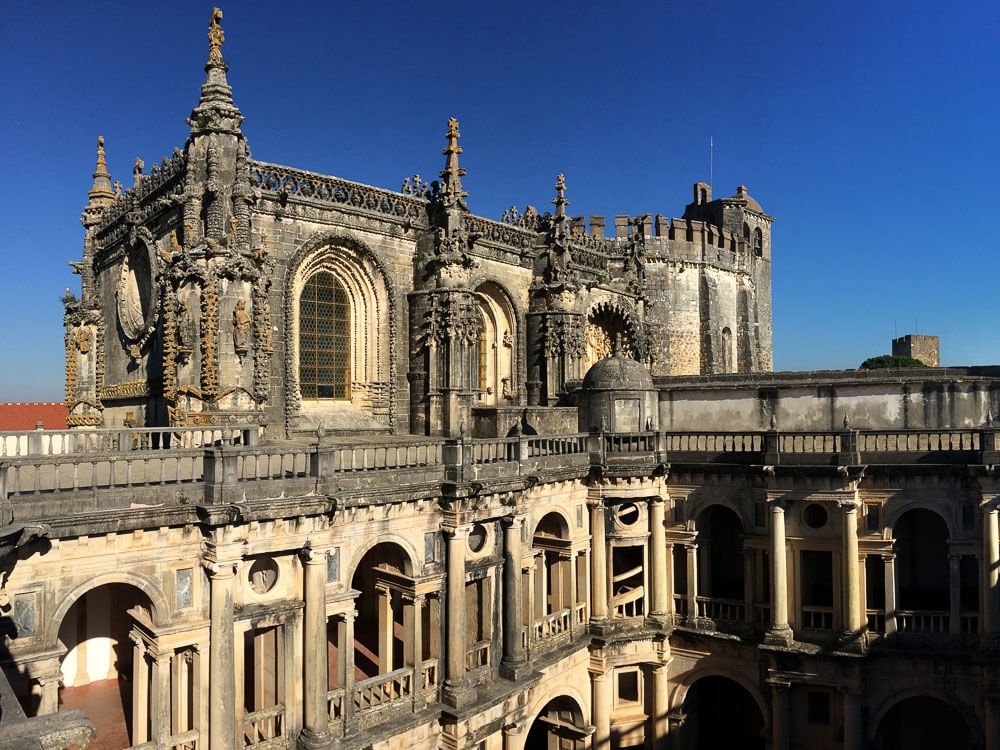
The Convent of Christ in Tomar, a UNESCO World Heritage site, is a historical landmark that has profound religious, economic and historical influence. Established in 1160 by Gualdim Pais, the fourth Grand Master of the Knights Templar, it initially served as the Templar Castle.
In 1420, Infante D. Henrique (Henry the Navigator) transformed the building into a convent. Later, in the 16th century, King Manuel I introduced Manueline-style architecture, enhancing its aesthetic appeal and historical importance.
During the political instability of the 19th century, figures like Costa Cabral were instrumental in protecting the site from looting and destruction, ensuring its preservation for future generations.
The Order of Christ at Tomar also played a significant role during the Age of Discovery. It provided financial support for explorations that established global maritime routes, contributing to the expansion of what would become the Portuguese Empire.
8. Architecture

The Convent of Christ in Tomar stands as a testament to architectural evolution, seamlessly blending Romanesque, Gothic, Manueline, Renaissance, and Mannerist styles. This unique combination makes the Convent one of the most significant religious complexes in southern Europe.
The Manueline style is particularly prominent, especially in the intricate window designs and stonework that reflect Portugal’s Age of Discoveries. Maritime motifs within this style highlight King Manuel I’s influence during the nation’s period of overseas expansion.
Additionally, the transition from the solid, grounded Romanesque architecture to the heights of Gothic design illustrates how architects adapted to new engineering techniques and evolving aesthetic tastes.
These architectural changes are evident across various chapels and cloisters within the Convento de Cristo, presenting a cohesive yet layered blend of design philosophies.
Every aspect, from vaulted ceilings to sculptural details, narrates the story of Portugal’s cultural and artistic development, making a visit to the Convent a journey through centuries of architectural innovation.
Get ready to explore the historical Convent of Christ

The Convento de Cristo, or Convent of Christ, is a UNESCO World Heritage Site in Tomar, Portugal. This site is important for its religious and architectural heritage and was once a key Templar city on the Iberian Peninsula.
Walking through it, you’ll see the history unfold, from its days with the Knights Templar to its transformation under the Order of Christ. It really shows how Portugal evolved over time, especially during the Age of Discoveries.
When I visited, I was struck by how each part of the convent showcased a fascinating mix of architectural styles, from Romanesque to Mannerist.
However, it’s not just about beautiful buildings; it’s about understanding the past. And the convent offers a deep, educational experience that will definitely enrich your appreciation of history!
So, if you’re in central Portugal or curious about Templar history and architecture, the Convent of Christ is a must-visit. It’s a place where history comes alive, and I’m sure you’ll leave with a deeper admiration and understanding of Portugal’s past.

